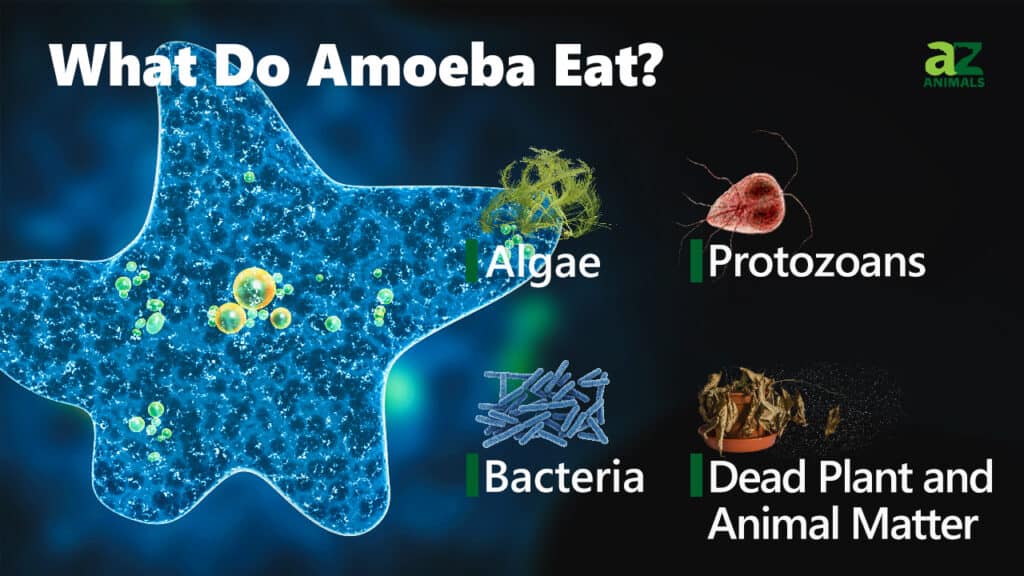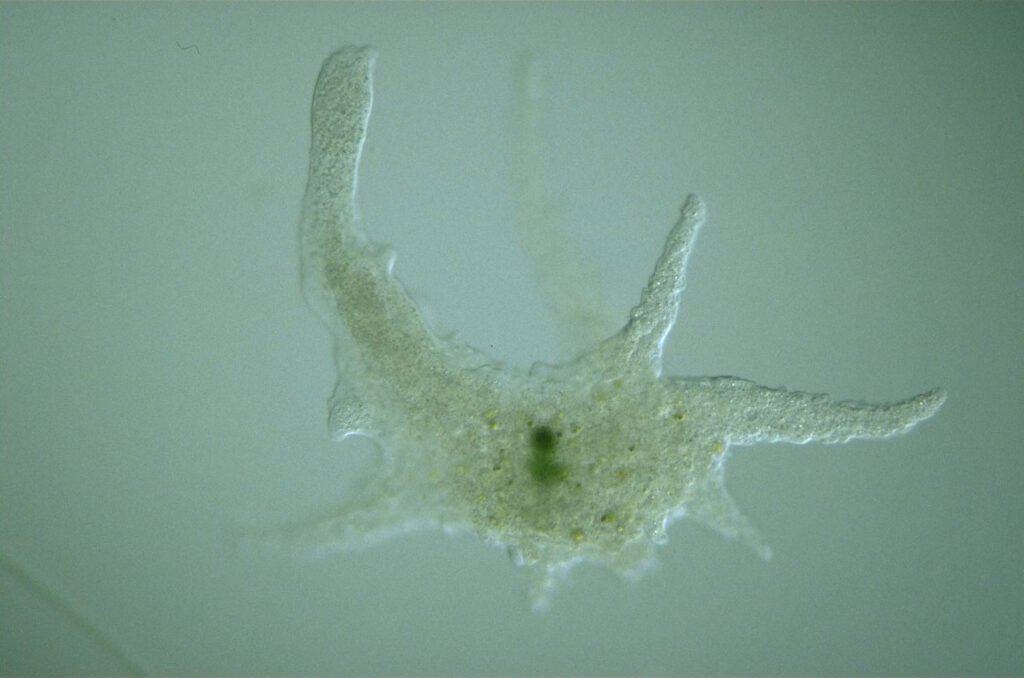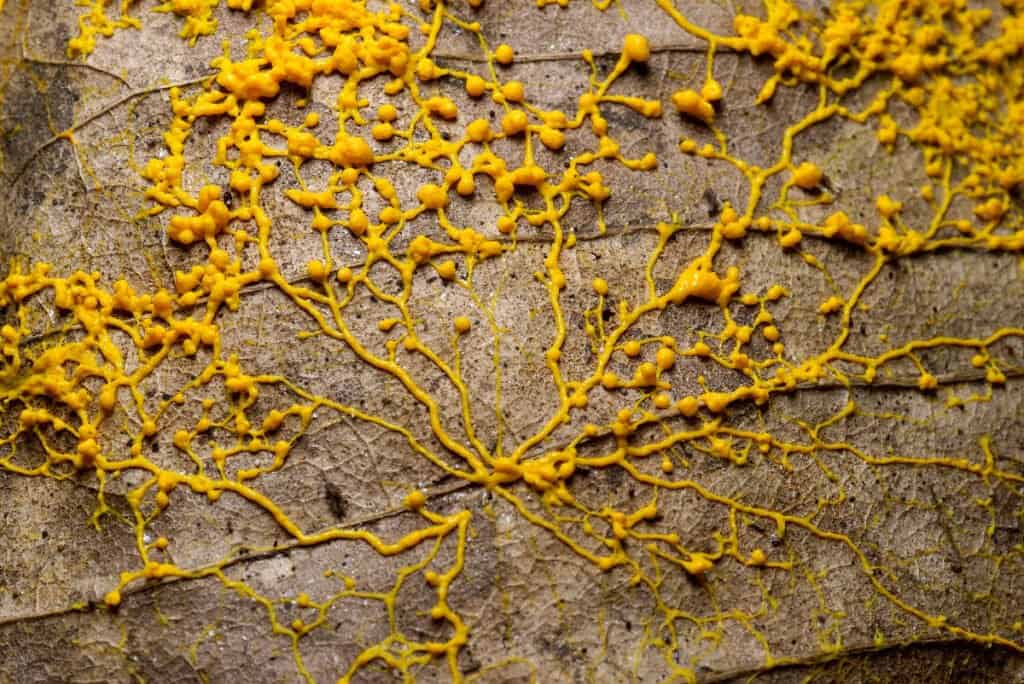As single-celled shape-shifters, amoebae can take on many sizes and forms. These organisms can grow to be much larger than you might think. For example, Syringammina fragilissima can get up to 8 inches in diameter. This is a massive feat for a one-celled organism. The name amoeba comes from the Greek word amoibē, meaning “change or transformation.”
Amorphous forms and a unique form of movement sets amoebas apart from other organisms. Their cells consist of a jelly-like liquid called cytoplasm. Amoebas move by using extensions of this cytoplam called pseudopodia, or “false feet” to propel them. They are protozoans, which are thought to be the most ancient ancestors in the evolutionary history of animals. Just like humans, amoebas are heterotrophs who can’t produce their own food. They have to get it from outside sources. So, what do amoebas eat?
What Do Amoebas Eat?

Amoebae eat a diet consisting of algae, bacteria, worms, nematodes, other protozoa, plant, and animal cells. They are omnivores whose diets vary depending on their species.
Some amoebae are parasitic or predatory and consume bacteria, other protozoa, or various cell types. Others are detritivores that ingest decomposing plant and animal materials. Amoebae primarily live in freshwater, saltwater, or soil environments. As a whole, bacteria are likely the primary material that amoeba consume, but diets vary significantly by species. We’ll discuss the diets of a couple of well-known species of amoeba, as well as the unique nutritional needs of some parasitic species.
Complete List of Foods Amoeba Eat
- Algea
- Bacteria
- Worms
- Nematodes
- Other protozoa
- Plant cells
- Animal cells
How Do Amoeba Eat?
Amoebas ingest their food through a process called endocytosis, meaning they engulf other cells or particles as food. First, they surround them with part of their cell membrane. Then, once the ingested material is surrounded, this part of the cell membrane buds off inside the cell. This forms a vesicle, a bubble-like structure within the cell that contains the ingested material. Finally, the materials inside the vesicle are digested by enzymes, and the process is complete.
In the case of the amoeba, it surrounds the desired target by extending its pseudopods. These temporary, finger-like projections engulf the matter and bring it into the cell. This is a type of endocytosis called phagocytosis, or “cell-feeding,” in which solid particles are ingested. An article in Applied and Environmental Microbiology discusses the eating habits of Acanthamoeba castellanii, a genus of amoebae that are commonly recovered from soil. These amoebas eat through phagocytosis and pinocytosis. Pinocytosis, or “cell-drinking,” refers to the ingestion of liquid particles.
What Do Different Types of Amoeba Eat?

“The giant amoeba,” Chaos carolinensis, feeds on bacteria, algae, other protists, and sometimes small invertebrates.
©dr.Tsukii Yuuji / Creative Commons – License
Chaos carolinensis, “the giant amoeba,” can reach lengths of up to 5 mm. Chaos feed on bacteria, algae, other protists, and sometimes small multicellular invertebrates. They’re primarily a scavenging species that feed on materials at the bottom of freshwater habitats. Amoeba proteus is also a large and well-known amoeba. It’s widely used as an example species for study in classrooms and is easily purchased from scientific supply companies. As another freshwater species, it feeds primarily on algae, rotifers, and other protists, sometimes even eating smaller amoebas. Whether living in saltwater, freshwater, or soil, amoebae are versatile eaters who adapt to feed on the microscopic materials of their environment.
Are Amoebas Dangerous to Humans?
Naegleria fowleri, or “brain-eating amoeba”, is an amoeba with quite a reputation. A dangerous infection occurs when this amoeba enters the human body through the nose. This can happen when swimming in freshwater areas like lakes or rivers. Once this brain-tissue-eating amoeba infects a human brain, it’s almost always fatal. However, the risk of Naegleria fowleri infection is actually incredibly low. Overall, viruses and bacteria pose greater threats to human health than an amoeba.
Although risks from amoeba may be comparatively low, there are a number of amoeba species that can have dramatic effects on human health. Entamoeba histolytica can infect the human guts and eat cells of the intestine, leading to amoebic dysentery. This is a serious illness that can lead to death in some cases. An amoeba called Sappinia diploid causes a rare and usually fatal central nervous system disease. Balamuthia mandrillaris is an amoeba that can infect the central nervous system, lungs, sinuses, and skin. The soil grazing amoeba previously mentioned, Acanthamoeba, can cause a potentially fatal central nervous system disease as well as a potentially blinding infection of the eye called keratitis.
How Do Amoeba Affect Other Species?

Bacteria is a common food for amoeba, some are even bacteria-farmers!
©yamaoyaji/Shutterstock.com
Some large forms of amoebae have bacteria and algae within their cytoplasm. These organisms have a symbiotic relationship with the amoebae as their hosts. Dictyostelium discoideum is a particularly interesting species of slime mold. These are soil-dwelling, social amoebae that have developed a special form of symbiosis. An article in Nature describes this incredible bacteria-farming amoeba. Individual amoeba joins together to form a multicellular, “slug-like” organism. This organism is able to move to new locations when resources in its habitat are scarce. This species of slime mold doesn’t come to its new home empty-handed- it actually brings the bacterium it has been eating along with it! This bacterium gets seeded in the new habitat and prospers, providing a stable source of nutrition.
The photo featured at the top of this post is © iStock.com/wir0man
Thank you for reading! Have some feedback for us? Contact the AZ Animals editorial team.






